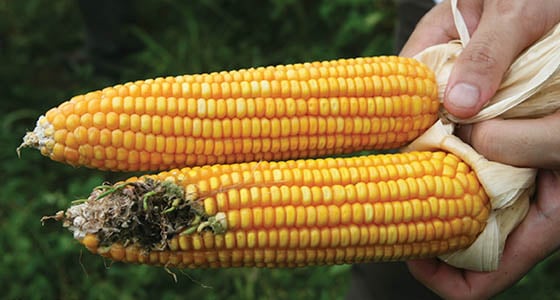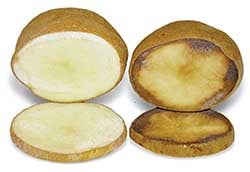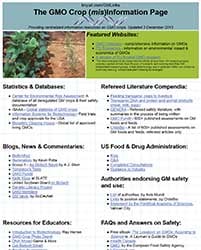GMOs: A Plateful of Promises
Although controversial, genetically modified crops are safe, efficacious, and necessary to meet future food needs and preferences.

Genetically modified (GM) crops, foods, ingredients, and feeds produced from them have been very much in the news. In the United States, voters have gone to the polls in California and Washington to reject initiatives that would have required mandatory warning labels on foods containing even traces of GM crop-derived materials. Connecticut passed a GM labeling bill that will not take effect until five other states adopt similar legislation; such legislative actions are pending in about 20 other states.
Campaigns for labeling initiatives use emotional claims, sensational graphics, and indignation-producing statistics to claim that GM crops are not sufficiently regulated by the government and are unsafe to eat and to release in the environment. Photos of lumpy rats taken by doctor-turned-researcher Giles Séralini have circulated widely, and are commonly cited as proof that GM corn is unsafe. Oprah, Dr. Oz, leading chefs, and assorted celebrities have spoken out against GM crops. The net result is that GMOs are now lumped together in the consumer’s mind with other foods that have been vilified rightly or wrongly, such as high fructose corn syrup (HFCS), trans fats, and artificial colorings and preservatives.
What Are GM Crops?
A major problem surrounding GM crops is that most people don’t understand what GM crops really are, and what they do know is often misinformation, which circulates widely in social media as well as in the mainstream media. The purveyors of GM crops and foods derived from them have totally failed to educate consumers, and the information vacuum has been filled by rumors, opinions, misinformation, and marketing opportunities for some products by sowing fear and distrust in GM foods.
GM crops are simply those varieties produced through the introduction of pieces of DNA to give them traits otherwise not possible. The technology has been used to make crops resistant to certain insects or herbicides, and/or protect them from viral diseases. Newer crops increasingly focus on traits of value to consumers, such as soybeans with oil that does not need hydrogenation, and thus does not lead to the production of trans fats, or potatoes that do not produce acrylamide when fried.
GM corn, soybean, canola, sugar beet, and cotton are the leading crops planted in the United States. GM papaya, squash, sweet corn, and alfalfa are also planted. GM rice, tomato, and potato varieties have been approved, but are not currently on the market.
In the United States, GM crops are reviewed by the U.S. Food and Drug Administration (FDA) for feed and food safety prior to marketing. There is a period of review and consultation, and once satisfied, the FDA advises developers that they have no further safety questions about new GM varieties, at which point the U.S. Dept. of Agriculture (USDA) approves the crop for marketing, as long as their own review and consultation reaches the same conclusion about environmental safety. For some traits, such as insect resistance, the Environmental Protection Agency (EPA) is also involved.
There have been 165 FDA pre-market consultations to date, covering 19 species. Because of the nature of the global market, the FDA counterparts in all major importing countries also conduct independent safety reviews before approving importation of the GM crop, so there is substantial redundancy in the safety assessment process.
Ingredients derived from soybean, canola, and corn (i.e., oils, starch, protein fractions, lecithin, mono- and di-glycerides, HFCS, tocopherols, and others) are used in many food products, as is sugar from sugar beet. It is estimated that at least 70% of processed food products in the United States have ingredients derived from GM crops (Cornell CES, 2003). It is, however, important to note that these ingredients are chemically identical to their counterparts isolated from non-GM crop plants and seldom contain DNA or protein associated with the GM trait. In the European Union, food products containing more than 0.9% of any of the above-mentioned food ingredients must be labeled as GM food.
 The first GM crops were planted in 1994, and statistics have been collected since 1996. The impact of GM technology on global agriculture during the past 17 years has been substantial. Approximately 10% of the world’s agricultural fields are now planted with GM crops. Last year alone, more than 17 million farmers in about 30 countries planted GM crops on over 420 million acres. The cumulative area planted over the past 17 years is equivalent to the size of the United States and Mexico, meaning that there is an abundance of information on how these crops have done in the real world. The dire consequences (e.g., the cancer epidemics predicted by Greenpeace) have not materialized.
The first GM crops were planted in 1994, and statistics have been collected since 1996. The impact of GM technology on global agriculture during the past 17 years has been substantial. Approximately 10% of the world’s agricultural fields are now planted with GM crops. Last year alone, more than 17 million farmers in about 30 countries planted GM crops on over 420 million acres. The cumulative area planted over the past 17 years is equivalent to the size of the United States and Mexico, meaning that there is an abundance of information on how these crops have done in the real world. The dire consequences (e.g., the cancer epidemics predicted by Greenpeace) have not materialized.
GM crops have increased harvests by decreasing losses to pests, decreased input and labor costs, reduced the impact from agrichemical use, helped conserve soil and water resources, and conferred a number of environmental and sustainability gains (Brookes and Barfoot, 2013). One of the major unanticipated benefits has been a reduction in greenhouse gas emissions from agriculture, equivalent to taking 22 million cars off the roads, which is roughly 36% of the cars registered in Great Britain (Brookes and Barfoot, 2013). Repeated claims that planting of GM crops would lead to catastrophic environmental disasters have not materialized.
From a food technology perspective, GM technology to improve color, flavor, nutrition, and other consumer-desirable traits is only now beginning to reach the marketplace. Improved low-polyunsaturated vegetable oils suitable for thermal processing and oils that are high in omega-3 fatty acids are two examples. There is a concerted push by the soybean industry to plant high-oleic soybeans on 25–30% of U.S. acreage by 2023. For the first time in history, oil comparable in quality to that of olive oil will be abundant at an affordable price.
It is worth noting here that national and international expert panels around the globe have repeatedly concluded that it will be exceedingly difficult, if not impossible, to meet the food and agricultural needs of future generations without the use of all available technologies (Solutions for Sustainable Agriculture and Foods Systems, 2013).
--- PAGE BREAK ---
 Mother Nature as Genetic Engineer
Mother Nature as Genetic Engineer
To understand the mythology surrounding GM crops, it is necessary to return to the origins of agriculture. Archaeologists estimate that the earliest agricultural settlements appeared about 10,000 to 13,000 years ago. Proto-farmers collected the seeds of edible wild plants and planted them in managed fields in the first attempts at agriculture (Hancock, 2012). It probably did not take long for these would-be farmers to notice that some plants were more desirable than others. They would have harvested seeds from the plants with the most edible portions, which produced higher yields, or tasted better, and saved them to plant the next season.
Fortunately for ancient farmers, crop plants experience a high rate of spontaneous DNA mutation, and there is even a baseline rate of gene transfer into crops from viruses, bacteria, and unrelated plants (Parrott, 2005; Weber et al., 2012). The resulting new crop varieties are not natural, do not exist in nature, and very often do not recognizably resemble their original wild ancestors. Some crops, such as bread wheat and strawberry, never existed in nature, and are entirely a product of human crossing.
Importantly, it is impossible to alter most of the appearance of a plant without changes in the underlying DNA. As such, domestication is the result of natural and induced genetic modifications that are screened and selected by humans. The modern crop genome contains such changes, along with genes that have been either lost or acquired along the journey to modern seeds (Parrott, 2005; Weber et al., 2012). Even more surprising is the observation that within the last five decades at least three new genes have evolved in modern crops. In recent times, plant breeders have learned to accelerate the process of genetic modification through the use of mutagenizing chemicals and radiation, through the development of methods that force crosses between plants that would not otherwise mate, and—controversially—through genetic engineering. These and other methods used for breeding plants, except for genetic engineering, result from what could be called “black box” genetic modification, since they produce unknown, random changes in DNA.
 To restate the obvious, all plant breeding depends on genetic modification. Genetic engineering is the most precise and predictable of the available breeding methods, which produces the fewest unintended and potentially undesirable changes into plants.
To restate the obvious, all plant breeding depends on genetic modification. Genetic engineering is the most precise and predictable of the available breeding methods, which produces the fewest unintended and potentially undesirable changes into plants.
Historically, different crop plants were developed in different regions of the world, since the wild ancestors of various modern crops can only be found in one or a few restricted geographical areas, called centers of origin. Tomato, potato, and maize originated in the Americas, rice from Asia, and wheat from the Middle East. Largely as a consequence of the era of European exploration, and more recently with the advent of modern transportation, the world’s diet has been globalized as crops were moved between continents (Chassy, 2010; 2014). The human diet changed dramatically when ancient hunter-gatherers became proto-farmers, and it has continued to evolve throughout history. Plant domestication, plant breeding, and crop globalization have all proven that humans are versatile omnivores and that crop breeding is almost without exception a safe undertaking (Chassy, 2010; 2014; Steiner et al., 2013).
Regulating the Safety of GM Crops
Following the initial reports of DNA engineering into plants, the Office of Science and Technology Policy asked the National Academy of Science (NAS) to consider the safety of GM crops. The NAS (1987) responded in this way: 1) GM crops pose no novel risks; 2) it is the safety of the product that is of concern and not the process used to produce it; 3) no new laws were needed to give government agencies the authority to ensure the safety for consumers, agriculture, and the environment since the risks were “the same in kind” as those presented by organisms bred using conventional methods. Nonetheless, the U.S. put in place a regulatory system that singled out GM crops for special regulatory scrutiny by FDA, EPA, and USDA.
FDA declined, however, to require mandatory labeling of GM crops, since it could identify no material safety or compositional difference between GM crops and their conventional counterparts. The exception is for crops whose composition is intentionally modified, such as high oleic acid vegetable oils. These have to be labeled, regardless of whether conventional breeding or genetic engineering was used to produce them. Other countries developed similar regulatory systems, and many have adopted a system of mandatory labeling. It has been estimated that the cost of approval of a new GM variety is some $35 million and the timeframe about five to 10 years.
Regulators focus safety assessment on two distinct issues: 1) hazards associated with the newly inserted DNA, expressed novel proteins, novel metabolites, and intended compositional changes and 2) hazards associated with unintended changes that might have occurred as a result of the DNA insertion (Chassy, 2010; 2014). It is a relatively straightforward process to characterize the inserted DNA, any protein products produced by the inserted DNA, and any compositional changes associated with the newly produced proteins. Paradoxically, this kind of characterization is exceedingly difficult to perform on plants bred using methods such as random mutagenesis, and is seldom if ever attempted. Knowledge of any history of safe use or prior consumption is also instructive. Almost all proteins are safe to consume, and the few toxic protein families that exist have been well-characterized. If a protein is digestible, does not adversely affect animals when administered in high doses, and does not structurally resemble known toxic proteins, it is most likely safe to consume, as long as it is not an allergen. Although a validated animal model for predicting protein allergenicity has not been developed, if a protein does not structurally resemble known allergens and is digestible, it is unlikely to be an allergen. GM breeding is no more likely to produce an allergen than is conventional breeding. The most common allergens are found in conventionally bred plants and animals that are prominent in the human diet.
Unintended changes occur in all breeding; however, it is inappropriate to automatically equate either change per se or unintended change with hazardous. There is no biological basis to believe that unique changes could occur in genetic engineering relative to conventional breeding. Two lines of evidence support this conclusion. Firstly, very careful compositional studies have demonstrated that the composition of GM crops is no different from that of their conventional versions (Herman and Price, 2013). Extensive studies have also shown that GM plants more closely resemble their parental strains at the level of gene transcription, proteins present, and metabolite composition than do different varieties of the same crop (Ricroch et al., 2011). These results show that genetic engineering is less mutagenic and disruptive than are other breeding methods. Therefore, there is no scientific justification to regulate, for example, an herbicide tolerant crop produced through genetic engineering, yet not regulate that same exact herbicide tolerance if obtained via mutagenesis. It is even less justifiable that breeders can breed in dozens if not hundreds of unknown genes from distant genera into crop plants (some of species which are even known to be toxic) without regulation, while a single gene transferred between two members of the same species is strictly regulated.
--- PAGE BREAK ---
What’s All the Fuss About?
If the science is so clear, why is there so much controversy about the safety of GM crops? A plethora of websites proclaim the harmful effects of consuming GM foods from crops (while ubiquitous foods from GM microorganisms are largely ignored). These sites often point to a handful of studies to support their premise, and consistently ignore the hundreds of studies that run counter to it, dismissing them as performed by industry, paid for by industry, or performed by scientists sympathetic to industry. Some have even argued that conventional experimental design and statistical analysis are not able to find the adverse effects present, and thus “alternative” types of experimentation and analyses need to be used. A disturbing trend is the publication of papers that claim to show evidence of harmful effects of GM crops, written by academic scientists, albeit usually from disciplines that are at best tangentially related, who are biased against GM crops but who project an air of objectivity. These papers are occasionally published in front-line, peer-reviewed journals, while others show up in third-tier, pay-for-publication online journals.
The first such paper published was by Ewen and Pusztai (1999), who claimed there were changes in the gastro-intestinal epithelial cells of mice fed GM potatoes. Pusztai went on Granada Television and warned the public against eating GM foods. The journal, Lancet, published the paper so that all could see the data. The Royal Society concluded that no meaningful scientific conclusion could be drawn from the flawed study; to this day, anti-GM activists continue to cite the study as evidence of the dangers of GM foods. More recently, Séralini claimed that feeding rats GM corn produced tumors. The paper appeared in a field-leading peer-reviewed Journal of Food and Chemical Toxicology. The seriously flawed study was met with widespread criticism from scientists around the globe (e.g., Arjó et al., 2013). On November 19, 2013, the journal retracted the publication. More recently, it has been claimed that consumption of GM corn is a major cause of gluten sensitivity in the absence of any direct clinical evidence. The claim is based on long jumps of logic, such as comparing the human gastrointestinal system to fish gills directly exposed to an unrealistically high doses of herbicide.
The extreme claims about GM crops highlight the need to examine the expertise, objectivity, and past track record of the writers, potential bias of those who report the research, and the motive for making anti-GM claims. Readers must distinguish between claims of harm based solely on the observation of statistically significant differences as opposed to a demonstration of a biologically significant outcome. Animal studies used for whole food studies are particularly difficult to conduct and vulnerable to artifacts, and thus are often cited as evidence of the harmful effects of GM foods (see preceding discussion of Ewen & Pusztai and Séralini). Whole food studies are poor predictors of safety, fraught with confounders, and are most likely an unethical use of animals (Kuiper et al., 2013; Bartholomaeus et al., 2013; Van Eenennaam, 2013). Reports claiming that exposure of isolated cells suffered harmful effects when exposed to a chemical or a protein associated with a GM crop also have become increasingly common. Just about anything that is added to a cell in a Petri dish can have negative consequences, particularly if there is no way that cell could ever be exposed to that substance if it was in its normal place inside the body. In fact, many common food ingredients are toxic in these in vitro systems.
 Finally, consumers need to beware anecdotes and logical fallacies. Anecdotes such as “I stopped eating GM foods, and my allergies went away” are not evidence, but they are a favorite activist tactic. The claim that allergies significantly increased after the introduction of GM crops is a perfect example of a post hoc fallacy that is commonly employed by GM critics.
Finally, consumers need to beware anecdotes and logical fallacies. Anecdotes such as “I stopped eating GM foods, and my allergies went away” are not evidence, but they are a favorite activist tactic. The claim that allergies significantly increased after the introduction of GM crops is a perfect example of a post hoc fallacy that is commonly employed by GM critics.
Undoubtedly part of the opposition to GM crops comes from genuine concerns about food and environmental safety, and these can usually be addressed by providing the necessary information. Other concerns are ideological in nature; anti-corporate feelings play a prominent role. There is also a highly motivated economic component behind opposition to GM crops. Sources of moral and economic support for the campaign against GM crops include the United Nations, the European Union, and individual European Union governments, foundations, and key organic food producers and purveyors of natural foods. The latter three invested heavily in the recent referenda on mandatory labeling of GM crops (Byrne and Miller, 2012). Although the campaign slogan is “the right to know,” prominent GM opponents are on the public record stating that mandatory labeling of GM crops is the first step to the total elimination of GM crops and foods.
What Can the Food Industry Do?
There is a clear temptation to assert that GM foods are a problem created by the biotechnology and agriculture sectors, and that it isn’t the food industry’s problem to defend GM crops and foods. Some companies are conflicted about the fact that they also produce natural and organic products; at least one of these companies has contributed to campaigns for and against GM crops. All too often, the concern that any particular brand will be viewed as less than 100% safe by consumers leads food companies to bow before public pressure—just witness the current move to claim “no high-fructose corn syrup” prominently on some labels. While there are clear short-term benefits from this strategy, it allows public opinion to become the arbiter of what is healthy and what is not, rather than specialists in the field. The inevitable outcome of such “science by plurality of opinion” is to ensure that food ingredients and novel technologies available to the industry are continuously attacked until removed from food products.
At this moment many consumers trust the activists on the issue of GM safety more than they do the food industry. The food industry and members of IFT need to invest time, resources, and energy to explain GM technology, why the world needs GM crops, and the food industry’s commitment to safety and sustainability.
Why Are There No Human Feeding Studies?
No unresolved hazards have been identified with GM crops thus far approved that would point to a need for further study.
The short answer to this question even if such a study were contemplated is that there are no laboratory strains of humans.
Human studies—as in drug trials—work to test known levels of known substances known to have a physiological effect.
In contrast, the purpose of feeding studies with whole GM foods is to detect a substance of unknown nature that may or may not be present.
There is no reason to believe that such hypothetical substances would be more likely to be created by genetic engineering than through other methods of breeding.
As explained in the accompanying article, these tests are notoriously difficult to conduct, even with laboratory rats. Humans are not nearly as uniform as rats, and would not want to live in a controlled room, eating the same food for years on end.
Bruce Chassy, Ph.D., is a Professor Emeritus of Food Science at the University of Illinois and is President of AcademicsReview.org, P.O. Box 399, Priest River, ID 83856 ([email protected]). Wayne Parrott, Ph.D., is a Professor of Crop and Soil Sciences, University of Georgia, 111 Riverbend Road, Athens, GA 30602-6821 ([email protected]).
References
Arjó, G., Portero, M., Piñol, C., Viñas, J., Matias-Guiu, X., Capell, T., Bartholomaeus, A., Parrott, W., and Christou, P. 2013. Plurality of opinion, scientific discourse and pseudoscience: An in-depth analysis of the Séralini et al. study claiming that Roundup™ Ready corn or the herbicide Roundup™ cause cancer in rats. Transgenic Res. 22(2): 255-267.
Bartholomaeus, A., Bondy, G., Parrott, W., and Walker, K. 2013. The use of whole food animal studies in the safety assessment of genetically modified crops: limitations and recommendations. Crit. Rev. Toxicol. 43(S2): 1–24.
Brookes, G. and Barfoot, P. 2013. Key environmental impacts of global genetically modified (GM) crop use 1996– 2011. GM Crops and Food: Biotechnology in Agriculture and the Food Chain 4(2): 109-119. www.landesbioscience.com.
Byrne, J. and Miller, H. 2012. The roots of the antigenetic engineering movement? Follow the money!” Forbes.com, Oct. 22. http://www.forbes.com/sites/ henrymiller/2012/10/22/the-roots-of-the-antigenetic- engineering-movement-follow-the-money/.
Chassy, B. 2010. Food safety risks and consumer health. New Biotechnology 27(5): 534–544. doi:10.1016/j.nbt.2010.05.018.
Chassy, B. 2014. Food Safety. Chapt. 27 in The Oxford Handbook of Food, Politics and Society, ed. Ronald Herring. Oxford University Press, Oxford (in press).
Cornell Cooperative Extension Service. 2003. Genetically Engineered Organisms Public Issues Education (GEO-PIE) Project. GE foods in the market.
Ewen, S.W. and Pusztai, A. 1999. Effect of diets containing genetically modified potatoes expressing Galanthus nivalis lectin on rat small intestine. Lancet 354(9187): 1353–1354.
Hancock, J.F. 2012. History of scientific agriculture: crop plants. eLS, August, http://onlinelibrary.wiley.com. doi:10.1002/9780470015902.a0003099.pub2.
Herman, R., and Price, W. 2013. Unintended compositional changes in genetically modified (GM) crops: 20 years of research. J. Agr. Food Chem., Feb. 15. doi:10.1021/jf400135r. Accessed March 13, 2013.
Kuiper, H.A., Kok, E.J., and Davies, H.V. 2013. New EU legislation for risk assessment of GM food: no scientific justification for mandatory animal feeding trials. Plant Biotechnol. 11: 781-784.
McDougall, P. 2011. The cost and time involved in the discovery, development and authorisation of a new plant biotechnology derived trait. A consultancy study for Crop Life International.
NAS. 1987. Introduction of recombinant DNA-engineered organisms into the environment: key issues. National Academy of Sciences, Washington, D.C.
Parrott, W. 2005. The nature of change: towards sensible regulation of transgenic crops based on lessons from plant breeding, biotechnology and genomics. In Proceedings of the 17th Meeting National Agricultural Biotechnology Council, pp. 209-220.
Ricroch, A.E., Berge, J.B., and Kuntz, M. 2011. Evaluation of genetically engineered crops using transcriptomic, proteomic, and metabolomic profiling techniques. Plant Physiol. 155: 1752–1761.
Solutions for Sustainable Agriculture and Food Systems. 2013. Technical report for the post-2015 development agenda prepared for the Thematic Group on Sustainable Agriculture and Food Systems of the Sustainable Development Solutions Network. http://unsdsn.org/thematicgroups/ tg7/.
Steiner, H.-Y., Halpin, C., Jez, J.M., Kough, J., Parrott, W., Underhill, L., Weber, N., and Hannah, L.C. 2013. Evaluating the potential for adverse interactions within genetically engineered breeding stacks. Plant Physiol. 161: 1587-1594.
Van Eenennaam, A. 2013. GMOs in animal agriculture: time to consider both costs and benefits in regulatory evaluations. J. An. Sci. Biotech. 4: 37. doi:10.1186/2049-1891-4-37.
Weber, N., Halpin, C., Hannah, L.C., Jez, J.M., Kough, J., and Parrott, W. 2012. Crop genome plasticity and its relevance to food and feed safety of genetically engineered breeding stacks. Plant Physiology 160: 1842–1853.
